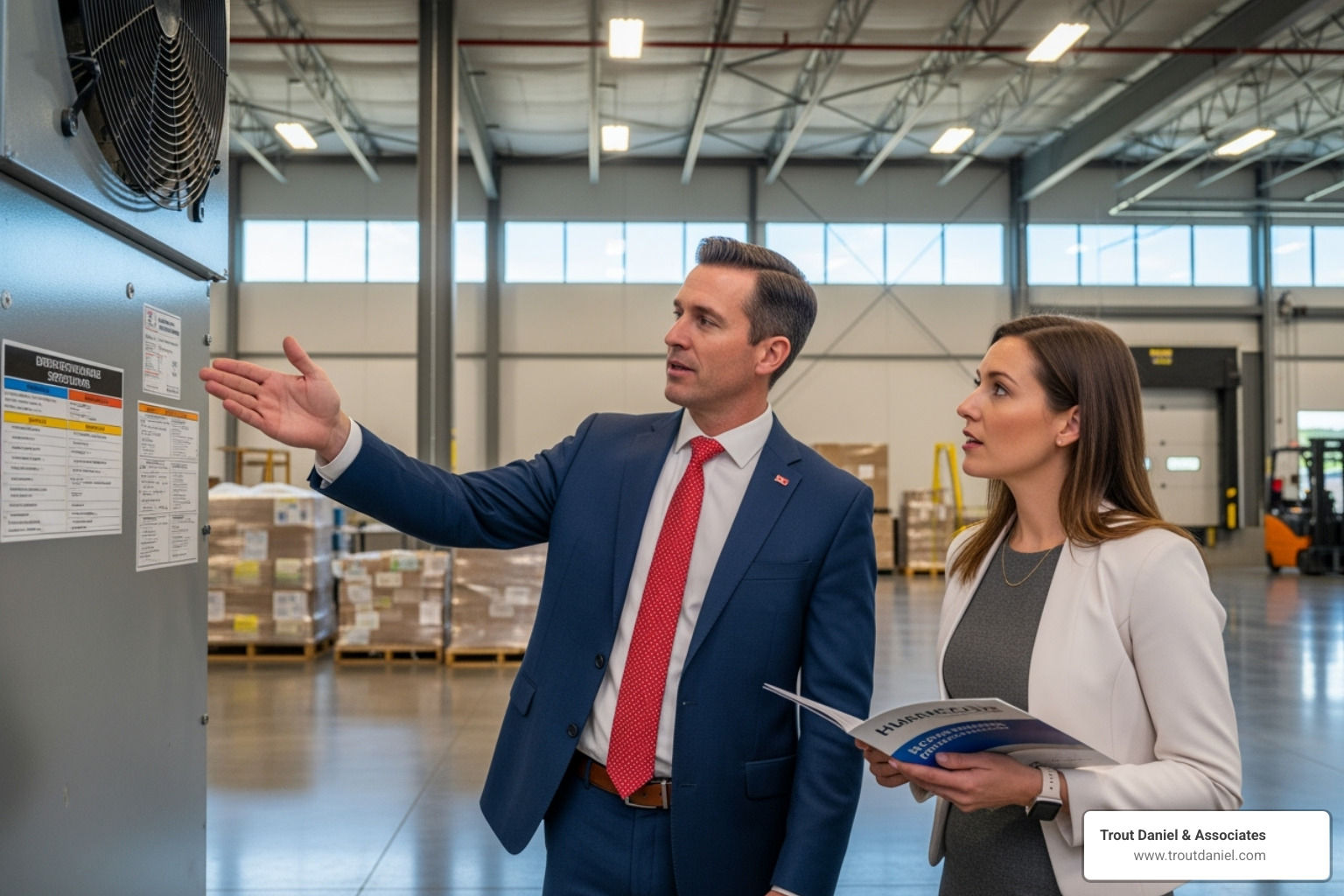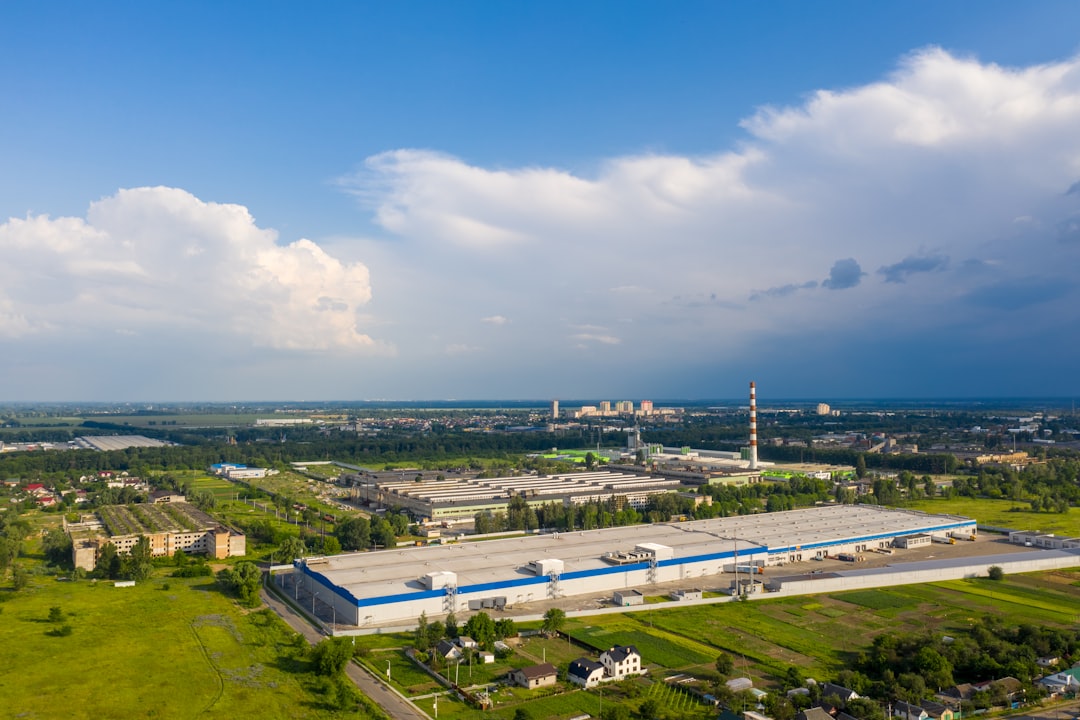Why Industrial Property Remains a Smart Investment Choice
An industrial property to buy is one of the most stable and profitable investments in commercial real estate. Properties like warehouses, manufacturing facilities, and distribution centers offer longer lease terms, lower tenant turnover, and steady cash flow compared to other commercial types.
Quick Answer: What You Need to Know Before Buying Industrial Property
- Property Types: Warehouses, distribution centers, manufacturing facilities, flex space, cold storage, and data centers
- Key Evaluation Factors: Location near transportation networks, zoning compliance, building condition, and expansion potential
- Typical Costs: Purchase price, closing costs (2-5% of purchase), property taxes, insurance, and ongoing maintenance
- Financing Options: Conventional commercial loans, SBA 504/7(a) loans, seller financing, and hard money loans
- Average Timeline: 60-120 days from contract to closing
- Important Metrics: Cap rate (typically 5-9.5% for industrial), net operating income (NOI), and price per square foot
The industrial real estate market has grown significantly, driven by the rise of e-commerce and the need for efficient supply chains. Industrial properties often lease or sell 14% faster than other commercial property types, with demand remaining high among top companies.
As managing partner at Trout Daniel & Associates, I’ve spent over three decades helping clients steer commercial real estate transactions, including the acquisition of industrial property to buy across multiple jurisdictions. My background in brokerage and economic development provides a unique insight into what makes an industrial property a sound investment.
This guide will walk you through the entire process, from understanding property types to closing your purchase and maximizing returns.

Understanding Industrial Real Estate: Types and Benefits
When you’re looking for an industrial property to buy, you’re entering a diverse market. Understanding the different property types is key to making a smart investment.
Warehouses are designed for storage, featuring high clear ceilings (often 24+ feet), open floor plans, and multiple loading docks. The e-commerce boom has made modern warehouse space highly sought-after for storing goods until they are needed.
Distribution centers are similar to warehouses but focus on rapid inventory turnover. Products are received, sorted, and shipped out quickly, often within 24-48 hours. These facilities require excellent access to highways, airports, and rail lines to ensure speed and efficiency.
Manufacturing facilities are where products are made. They require specialized infrastructure, such as heavy-duty 3-phase power, reinforced floors for machinery, robust ventilation, and sometimes overhead cranes.
Flex space buildings combine warehouse functionality with finished office space. This hybrid design is ideal for businesses needing both operational and administrative areas in one location, such as a 70% warehouse and 30% office split.
Cold storage facilities are specialized warehouses with refrigeration and freezing systems, essential for the food, pharmaceutical, and chemical industries. They command premium rents due to their specialized nature and high operating costs.
Data centers are the newest category, housing servers and telecommunications equipment. These secure facilities require massive power and cooling infrastructure to support our growing digital world.
So why invest in industrial property to buy over office or retail? The benefits are significant:
- Longer Lease Terms: Industrial tenants often sign leases for five to ten years or more, compared to shorter terms in office and retail. This provides more predictable income.
- Stable Cash Flow: With fewer tenant improvement costs than office spaces, expenses are more consistent, leading to reliable cash flow.
- Lower Tenant Turnover: Relocating an industrial operation is expensive and disruptive, so tenants tend to stay put. This means fewer vacancies and lower re-leasing costs.
- Resilience: The industrial sector is remarkably resilient. Even in economic downturns, goods must be produced, stored, and distributed. The growth of e-commerce has only strengthened this trend.
Here’s how industrial properties compare to other commercial real estate types:
| Feature | Industrial Property | Office Property | Retail Property |
|---|---|---|---|
| Lease Term | Typically 5-10+ years | Typically 3-7 years | Typically 3-5 years |
| Tenant Turnover | Low (costly to relocate operations) | Moderate (influenced by market and business growth) | High (influenced by consumer trends, competition) |
| Capital Expenses | Moderate (roof, HVAC, parking lot) | High (tenant improvements, common area updates) | High (storefront updates, common area maintenance) |
| Market Drivers | E-commerce, supply chain, manufacturing, logistics | Employment growth, business services, technology | Consumer spending, demographics, e-commerce competition |
| Resilience | High (essential for goods movement) | Moderate (hybrid work models, economic cycles) | Moderate (vulnerable to online shift, economic dips) |
| Management Focus | Infrastructure, access, security | Tenant experience, amenities, aesthetics | Foot traffic, marketing, tenant mix |
At Trout Daniel & Associates, we’ve helped countless clients steer the industrial property market. Whether you’re a first-time investor or an experienced portfolio owner, we can guide you through every step. Learn more about our industrial property services and find how we can help you find the right property.
Key Factors to Consider When You Find an Industrial Property to Buy
Finding the right industrial property to buy requires evaluating several key factors beyond the price tag. A thorough analysis ensures the property will meet your needs and perform well as an investment.

Location and Accessibility
Location is the one thing you can’t change about a property, and for industrial real estate, it’s critical. The best properties connect your business to the world efficiently.
- Highway Access: Proximity to major interstates reduces transportation time and costs, directly improving your bottom line.
- Proximity to Ports and Rail: For businesses involved in national or international trade, being near ports or rail lines significantly cuts down on logistics costs and turnaround times.
- Last-Mile Logistics: With the growth of e-commerce, properties near urban centers are vital for distribution centers aiming to provide fast delivery to consumers.
- Labor Pool Availability: A location in a region with a skilled and available workforce saves time and money on recruitment and training.
These factors combine to create supply chain efficiency. At Trout Daniel & Associates, we help clients find locations where these logistical pieces align with their operational needs across our service areas, from Maryland to Texas.
Zoning and Legal Considerations
Navigating zoning and legal issues is crucial to avoid costly problems. This due diligence protects your investment.
- Zoning Laws: Verify the property’s zoning classification (e.g., light industrial, heavy industrial) and ensure its permitted use aligns with your business activities. Don’t assume a general “industrial” zone allows for your specific operation.
- Environmental Regulations: Always conduct a Phase I environmental assessment to check for past contamination from chemicals or hazardous materials. If concerns arise, a Phase II assessment (with soil and water testing) may be necessary.
- Title Search: A thorough title search uncovers any liens, easements, or restrictions that could limit your use of the property or affect your ownership rights.
- Property Survey: A current survey confirms legal boundaries and identifies any encroachments, preventing future disputes.
- Government Surplus Opportunities: At times, federal and state agencies dispose of warehouse and industrial facilities via public sale or auction. You can browse current listings at the GSA’s official portal: Government surplus properties.
Building Condition and Features
The physical characteristics of the building directly impact its functionality and long-term costs.
- Clear Ceiling Height: Modern warehouses need at least 24-foot clear heights to maximize vertical storage space. Lower ceilings limit storage capacity and efficiency.
- Loading Docks and Truck Court: Evaluate the number and type of loading docks (dock-high vs. drive-in). Ensure the truck court provides adequate space for large trucks to maneuver safely.
- Power Supply: Manufacturing and other heavy operations often require 3-phase power. Upgrading a property’s electrical service can be very expensive, so check the existing capacity.
- Floor Load Capacity: The concrete slab must be able to support the weight of your machinery and inventory. Reinforced floors are necessary for many industrial uses.
- Building Age and Condition: Assess the overall condition, paying close attention to the roof, HVAC systems, and structural integrity. A well-maintained older building can be a better investment than a neglected newer one.
A comprehensive inspection report is essential for budgeting for immediate repairs and future capital expenditures.
Potential for Expansion and Value-Add
Great investments often have potential for future growth and improvement. Look beyond what the property is today to what it could become.
- Excess Land: A larger lot with undeveloped land provides flexibility for future building expansions, additional parking, or outdoor storage.
- Redevelopment and Renovation: Consider if the property can be renovated or redeveloped to increase its value. Modernizing office space, upgrading loading docks, or improving energy efficiency can attract better tenants and higher rents.
- Future Growth: Analyze the surrounding area for planned developments, new infrastructure, or population growth that could increase demand for your property.
Common value-add improvements include upgrading electrical systems, enhancing security, improving paving and drainage, and adding specialized equipment. Viewing an industrial property to buy as a dynamic asset that can evolve with the market is key to turning a good property into an exceptional investment.
The Financials: Costs and Financing Your Purchase
Understanding the complete financial picture is essential when you’re looking at an industrial property to buy. A clear view of all costs and financing options will help you make a sound investment decision.
Typical Costs Associated with an industrial property to buy
The purchase price is just the beginning. Be prepared for these additional expenses:
- Purchase Price: The foundational cost, which varies widely by location, size, and condition.
- Closing Costs: Expect to pay 2-5% of the purchase price for expenses like attorney’s fees, title insurance, appraisal fees, and loan origination charges.
- Property Taxes: A significant ongoing expense that must be factored into your annual budget.
- Insurance: Essential for protecting your asset against fire, liability, and other risks.
- Maintenance Costs: Covers routine upkeep. Even with a triple-net (NNN) lease, landlords are often responsible for structural items like the roof and foundation.
- Capital Expenditures: Funds set aside for major replacements, such as a new roof or HVAC system. Budgeting for these prevents future financial strain.
One key metric for evaluating an investment is the capitalization rate (cap rate). It’s calculated by dividing the property’s net operating income (NOI) by its purchase price. This gives you a snapshot of its potential return. Industrial cap rates typically range from 5% to 9.5%, with higher rates often indicating higher potential returns but possibly higher risk.
Financing Options
You have several paths to finance an industrial property to buy. The right choice depends on your financial situation and business goals.
- Conventional Commercial Loans: Offered by banks and credit unions, these loans typically require a 20-30% down payment. Lenders will review your credit, business financials, and the property’s income potential.
- SBA 504 Loans: Backed by the Small Business Administration, these are great for owner-users. They offer low down payments (as little as 10%) and long-term, fixed-rate financing for acquiring fixed assets like real estate.
- SBA 7(a) Loans: More flexible than 504 loans, these can be used for real estate, working capital, and equipment. They are popular with businesses needing to fund both the property and operational costs.
- Seller Financing: In this arrangement, the seller finances a portion of the purchase, which can speed up the transaction and offer more flexible terms. It’s a useful option if traditional financing is difficult to secure.
- Hard Money Loans: These are short-term, asset-based loans from private investors. They are faster to obtain but come with higher interest rates, making them suitable for short-term needs like quick acquisitions or renovations before refinancing.
The right financing structure is crucial. Our investment services team can help you steer these options to find the best fit for your goals. Learn more about our investment services here.
The Buying Process and Maximizing ROI
Acquiring an industrial property to buy is a strategic journey. Following a clear process and implementing smart management strategies are key to a successful investment.

Step-by-Step Guide to Buying
The path to owning an industrial property follows a logical sequence:
- Define Your Needs and Budget: Before searching, determine your requirements for size, ceiling height, loading docks, and power. Establish a realistic budget that includes all associated costs.
- Find the Right Broker: A specialized commercial real estate broker provides market knowledge, access to off-market deals, and expert negotiation skills.
- Property Search: Your broker will conduct a targeted search to find properties that match your criteria, filtering through numerous listings to identify the best opportunities.
- Write a Letter of Intent (LOI): This non-binding document outlines your proposed terms (price, timeline, contingencies) and signals your serious interest to the seller.
- Due Diligence: This critical 30- to 60-day period is for verifying all aspects of the property. It includes building inspections, environmental assessments, title searches, and a review of all financial and legal documents.
- Secure Financing: While performing due diligence, finalize your loan. Having financing arranged ensures a smooth transaction.
- Close the Deal: The final step where legal documents are signed, funds are exchanged, and ownership is officially transferred. The entire process from contract to closing typically takes 60 to 120 days.
How to Maximize Your Return on an industrial property to buy
Buying the property is just the start. Maximizing your return on investment (ROI) comes from effective management.
- Leasing Strategy: Set competitive rental rates and market vacant spaces effectively to attract quality tenants. Highlight key features like location, ceiling height, and power capacity.
- Triple Net (NNN) Leases: This common lease structure in industrial real estate has the tenant pay for property taxes, insurance, and common area maintenance. This creates a more predictable net income for the landlord.
- Strategic Property Improvements: Upgrades like modernizing office space, adding loading docks, or installing energy-efficient lighting can boost rental rates and property value.
- Tenant Retention: Keeping good tenants is cheaper than finding new ones. Be responsive to maintenance needs and offer fair renewal terms to encourage long-term occupancy.
- Proactive Maintenance: Regular inspections of the roof, HVAC, and other key systems prevent small issues from becoming costly repairs and keep the property in excellent condition.
Professional property management can be invaluable, especially for investors. Our team at Trout Daniel & Associates handles everything from tenant relations and rent collection to maintenance and financial reporting, ensuring your property is a profitable, well-maintained asset. Learn more about our professional property management services.
Frequently Asked Questions about Buying Industrial Property
Buying an industrial property to buy can bring up many questions. Here are answers to some of the most common inquiries we receive.
What are the main types of industrial properties?
Industrial properties vary widely. The main types include:
- Warehouses and Distribution Centers: Focused on storage and rapid movement of goods, essential for e-commerce and logistics.
- Manufacturing Plants: Equipped for production with specialized infrastructure like heavy power and reinforced floors.
- Flex Spaces: A hybrid of warehouse and office space, offering versatility for businesses that need both.
- Specialized Facilities: These include cold storage for perishable goods and data centers for technology infrastructure.
What is a ‘cap rate’ and why is it important?
The capitalization rate, or cap rate, is a simple metric used to estimate a property’s potential return on investment. It is calculated by dividing the property’s Net Operating Income (NOI) by its purchase price. The cap rate allows you to quickly compare the profitability of different investment opportunities. A higher cap rate generally suggests a higher potential return but may also indicate higher risk, while a lower cap rate often signifies a safer, more stable investment.
How long does the industrial property buying process typically take?
While every deal is different, a typical industrial property purchase takes 60 to 120 days from contract to closing. This timeline is primarily driven by two parallel processes:
- Due Diligence (30-60 days): This is the period for conducting thorough inspections, environmental assessments, title searches, and financial reviews.
- Securing Financing (30-90 days): This involves the lender’s underwriting process, which includes appraisals and review of all documentation.
Once due diligence is complete and the loan is approved, closing the transaction usually takes another one to two weeks. Our team at Trout Daniel & Associates anticipates potential delays and works proactively to keep your transaction on schedule.
Conclusion
We’ve covered the essential steps and considerations for purchasing an industrial property to buy. From understanding the different property types to navigating the financials and closing the deal, you are now better equipped to make a smart, informed decision. Industrial real estate is about opportunity, stability, and the future of commerce.
Remember these key takeaways:
- Location is paramount. Proximity to highways, ports, and a strong labor pool is the foundation of a successful industrial investment.
- Due diligence is your safety net. Thorough inspections, environmental assessments, and legal reviews protect you from costly surprises.
- Know your numbers. A clear understanding of costs, financing, and metrics like cap rates empowers you as an investor.
The industrial market continues to expand, driven by e-commerce, modern logistics, and a resurgence in North American manufacturing. This means that an industrial property to buy is not just a current opportunity but a long-term strategic asset.
At Trout Daniel & Associates, we bring over three decades of experience and a boutique approach to every transaction. We provide one-to-one consultation and serve as your single point of contact, guiding you through the complexities of the process. Our expertise across multiple jurisdictions gives us the deep market knowledge needed to secure better outcomes for you.
Whether you’re an owner-user seeking a facility to grow your business or an investor looking for stable returns, we are here to help.
Ready to find your ideal industrial property? Contact us to start your industrial property search and find how our expert guidance can make all the difference.



